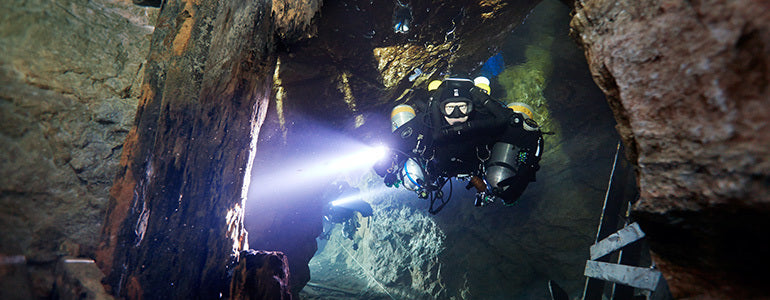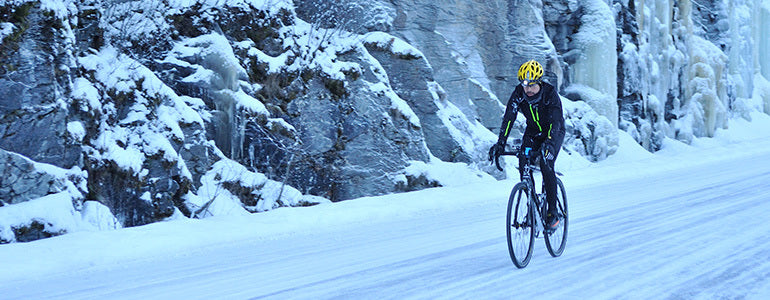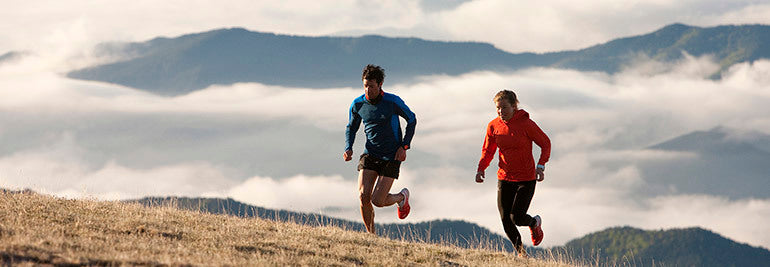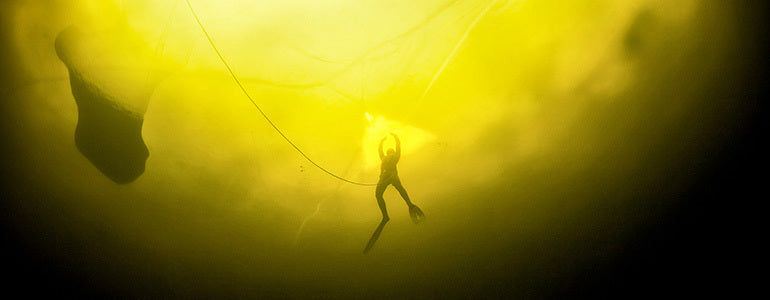

Suunto Blog

7 off-season tips for divers
Technical diver and commercial dive supervisor Andy Torbet began exploring the ocean when he was 12 and has been at it ever since. He’s explored sunken cities, elaborate cave systems, deep wrecks and reefs. We caught up with Andy just before he left for an expedition and asked what divers should do to stay dive-ready in the off-season. Here are his 7 off-season tips.
Don’t have an off-season
My personal recommendation for the off-season is not to have one. Even if you dive only very occasionally, and the dives are shallower and shorter than normal or even in a pool, it will help. They will keep those essential skills from fading and make sure your kit is working and familiar. Most diving incidents and accidents happen every year in spring when people come back to diving after taking the winter off. Just a quick dive a few times over the winter will help you stay on top of your game.
Andy explores Finland's Ojamo Mine, where Suunto tests its dive products. © Janne Suhonen “Most diving accidents happen in spring when people come back to diving after taking the winter off.”
Diving’s not physical, but it’s also physical
Diving is not primarily a physical performance sport but it is still physical. Recent medical investigations supported by incident reports have shown that your body is put under pressure even on simple dives and the more physically robust we can make ourselves the safer we are.
Why fitness matters
Ask yourself this: if two divers had identical diving skills, experience and attitude would you rather dive with the fit one or the out of shape one? Which diver do you think would have the greater chance of having a problem and which would you rather count on? Being physically fit can help in nearly all situations and is particularly important in some situations, from finning against a strong current, towing a casualty on the surface or just hauling oneself out of the water in a less than ideal condition. “Being physically fit can help in nearly all situations.”
© Martin Hartley
Take care of your body
It’s worth keeping a basic level of activity going in the off-season to keep you healthy for the new season. I know a lot of divers who go hill walking in winter just to keep their bodies active. But it’s also a time to look at doing some work on those problem areas you’ve been putting off (because you were too busy diving). Perhaps it’s a sore shoulder or a weak knee. Make sure you start the new season in the best shape possible. That way you can dive more, enjoy it more and be capable of more.
Core strength is key
Diving kit is heavy so spend some time working on your strength, and especially core strength. I’ve seen a number of dives cut short because someone injured their lower back getting kitted up. You can spend the spare time in the off-season getting into the habit so when you start diving again these exercises have become part of your routine.“I’ve seen a number of dives cut short because someone injured their lower back getting kitted up.”© Janne Suhonen
Maintain and take stock
I don’t have an off-season, but the winter is less busy so I use that period to service equipment, look at what needs replacing or go over the last year and see what I could can change or improve for next year. It’s an opportunity to take stock and look to improve.
Stay inspired
Keep yourself inspired. The off-season is also a good time to start planning projects or booking those courses you want to get done. Get the paperwork side of things done when the weather is bad to make full use of your time when it’s time to start diving.

Meet the Italian guy who cycles insane distances
Omar is returning to the Arctic Circle next winter. © Omar di Felice
How was the Arctic? It was a once-in-a-lifetime experience! The roads were treacherous with spots of ice and snow all the way. The longest stage was the third; 203 km with an average temperature of -18° C! Staying on my bike for 10 hours in those conditions required a huge a mental effort. I often said to myself, “Hey Omar, you worked hard to come here, so enjoy the ride, look at the beautiful landscapes, and don’t think about effort.” Ride and smile: that’s the secret! Was it like being in a freezer? Yes, it was - 10°C to -34°C! I wore a specific Arctic base layer of merino wool. Then I wore cycling clothes and, to keep my hands and feet warm, I wore winter cycling shoes and two pairs of gloves.
The way to pass over your limits is with mind power.
The bicycle had studded tires and disc brakes. © Omar di Felice
What attracts you to the Arctic Circle? Cycling in the Arctic Circle is like a dream: the sound and the colour of the landscape are unreal! After one tough stage, I saw the magical northern lights. What is ultracycling all about? Ultracycling starts where standard cycling ends. During Tour de France you can rest and recover and usually you don’t face extreme weather conditions. I love to explore extreme environments and to stay on my bike for hours and hours.
The colors and quiet of the landscape is what attracts Omar to the Arctic Circle. © Omar di FeliceHow did you get into it? When I finished my ‘standard cycling’ career I tried to find something that would allow me to explore my limits. So I started cycling alone, for more than 10 hours at a time. I did my first extreme cycling race in 2011 and fell in love with it. Why do you enjoy it? I enjoy the ability to explore the world at the speed and in the manner I prefer. For example, in 2015, when I cycled from Paris to Rome (1600 km) nonstop, I passed by the Tyrrhenian Coast, through the Alps, and two countries in only 72 hours. Exploration is one of my considerations when I look for an extreme challenge.
Omar says cycling in the Arctic Circle is like a dream. © Omar di FeliceDo you prefer racing or your solo adventures? I’ve won races like the Race Across Italy, Le Raid Provence Extreme, Ultracycling Dolomitica and Le Tour du Mont Blanc and enjoy the intensity. But my solo adventures are more fascinating: it’s a fight against myself! I decide on a route, and I try to reach the goal in a predetermined time. Training keep you busy?Depending on the time of the year I ride between 400-500 km to 600-700 km per week. I don’t like to spend all my energy during training. It’s important to train well but also to arrive at race day with full mental and physical energy.
Ride and smile: that’s the secret!
Due to the conditions Omar limited his speeed to 22-23 km/h. © Omar di Felice
How do you train? Recently the level of competition has become very high. To win the Race Across Italy, for example, I rode for 29 hours at a high average speed. This means I have to train for both endurance and power. For Back to the Arctic, I trained during the night and in cold conditions, wearing summer apparel to acclimatise my body. How does technology help you? I’m very fascinated by the science of training. My Suunto Ambit3 Sport helps me monitor progress during and after training by analysing performance data. The watch is also useful for social media as one of the most important things for an athlete is telling the story of an adventure!
© Omar di FeliceWhat’s next for you? Next winter I’ll do another Arctic cycling adventure, but this time Iceland’s 1358 km ring road. In September, I will attempt my longest ride yet – 2000 km from Pau in the French Pyrenees to the top of Stelvio Pass in northern Italy, crossing the Pyrenees, Mont Ventoux and the French, Italian and Swiss alps along the way.

Meeting Nepalese trail runner Mira Rai
Meet the former Maoist child soldier turned trail runner who is blazing a trail for Nepalese women.
© Martina ValmassoiYou can be forgiven if you haven’t heard of Mira Rai. But the young Nepalese trail runner is fast making a big impression after turning up on European soil. In June last year she won the Mt Blanc 80 km, 20 minutes ahead of her nearest rival and came second, just four minutes behind Emelie Forsberg, at the 100 km Ultra Pireneu in the Pyrenees last September. Hers is a remarkable story: she grew up in small village with just three families living on top of a hill, escaped aged 14 to join the Maoists and trained as a soldier. Always competitive, she later took up running, was talent-spotted in Kathmandu and switched to trail running, winning her first race, a 50 k, in March 2014 wearing a $4 pair of shoes. During the race, she stopped once to borrow 50 rupees to buy noodles and a carton of orange juice.
© Richard BullIt was tough growing up, she says, but also rewarding. “From a young age I carried water and collected fodder for the animals, and later I did a lot of work carrying heavy bags of rice to the market. It was hard, but now I know it made a difference for me.” It may seem surprising but she volunteered for the Maoists for the opportunities they afforded. “I joined for different reasons,” she says. “We certainly had financial difficulties in home, I wanted an opportunity to learn new things, and I wanted a chance to prove that women can be equal to men. Maoists respected women soldiers also.” Her manager Richard Bull, who arranged for her to compete in Europe, takes up the story. “Mira has told me that it was a choice between being stuck in the village doing the hard work required to keep life going, or taking a chance and seeing where it would lead. It’s a tough life in the village, and especially tough for girls as they are ultimately the workers.”
© Martina ValmassoiBeing competitive is in her blood though. “She and her friends would compete at the daily household chores, like who could cut grass for the animals quicker, who could carry the bigger load or reach the destination faster,” says Bull. Her good fortune was to join the Maoists as Nepal’s 10 year civil was ending and she never saw combat. “We did a lot of training in different sports, and different exercises, drills and skills to be fit. It was also a chance to compete against others in sports which I enjoyed a lot.” Her big opportunity came years later after her Maoist sports coach Dhruba Bikram Malla heard she was thinking of moving to Malaysia to work in a factory. He invited her to Kathmandu to try to run seriously. However, mountain running was unheard of. “Athletics organisations in Nepal focus on track up to marathon distance - IAAF recognised distances,” adds Bull. “The coaches dislike trail running as ‘it makes runners slow’. So all focus is on the track and marathon. In Kathmandu in her early 20s, she was trying for any event that came up – 10 km, 15 km etc.”
And that’s when she had a chance encounter with some runners who invited her to the 50k race that she won. “A week afterwards I met her,” adds Bull. “I told her about this sport and asked if she would like to try it. She looked a little bit incredulous, as if she thought ‘hilly up down running’ as she called it was a ridiculous idea. But slowly she came around to the idea that her potential was not on the track and she could try ‘hilly up down running’.” It’s safe to say there’s now no turning back for the athlete. “My goal is to run for a few years, to run really hard and do the best I can,” adds Rai, “then to help more Mira Rais to run, and to try and support them as best I can!”
Nepal is struggling to recover from a devastating earthquake that struck in 2015. To support the recovery, Suunto created the Ambit3 Nepal Variant. With every watch sold, Suunto will donate €25 to the Nepal earthquake rehabilitation operation. More here.
MAIN IMAGE: Lloyd Belcher
THE LOST ART OF NAVIGATION
It may seem old-school but using a map and compass, and gaining a little knowledge on your surroundings, will add to your outdoors experience, finds Tarquin Cooper.
I emerge out of a forest into thick mist – visibility is reduced to around 50 m – and the way ahead to the summit is not clear. There’s something that looks like a path ahead but it’s easy to get disorientated and I want to double check. And that’s when I do something that amazes my ski-touring partner. I pull out a map and compass. He makes a strange snorting noise – a mix of derision and laughter. The irony is, I was wearing my Ambit3. In just a couple of button pushes I could have checked the waypoints I’d inputted the night before. But the truth is, there’s just something mentally satisfying about working out where you are on a map, aligning it alongside a compass, and checking the bearing. Despite the disparaging comments from my companion, I’m not the only one who’s a fan of the lost art of navigation.
Alastair Humphreys
British adventurer Al Humphreys, who has popularized the concept of ‘micro adventures’ – short escapes from the city, also agrees. “I get quite lazy,” he says. “When I use a GPS I just press go and follow the instructions and pay no attention. For me, part of the experience of being out in the wilderness is moving competently, interpreting funny bits of the map. It’s more about the aesthetic and challenge than the practical, and it adds to the experience.”
Henrik Palin, Suunto’s product manager for compasses, says navigating with a map and compass can be more rewarding, in the same way it is to cook your food over an open fire. “It can be a bit more exciting,” he says.
He adds that there are also safety advantages to using a map and compass. “There’s the convenience and simplicity – you don’t have to wait for anything to switch on,” he says. “It also gives you more freedom for ad hoc navigation. If you’re relying on waypoints that’s all you have, whereas, if you have a big map, you can see interesting features like a nice lake, for example, which you can then navigate to using the compass.”
Today, most adventurers view a map and compass in the same context as other safety equipment such as first aid or an emergency blanket – something that always goes in the rucksack.
An old map from Al Humphreys’s office.
Maps themselves also have an intrinsic value beyond navigation, adds Humphreys. The walls of the log cabin where he works and writes his books are plastered with maps from around the world.
Humphreys says maps serve two purposes, as a means to navigate, but also as objects, like books. “I love maps for daydreaming about future trips and about reminiscing about old adventures,” he adds. “Some maps are things of artistic beauty.
Tristan Gooley
One person who has taken the art of navigation to a new level is Tristan Gooley. As an adventurer he is the only living person to have flown and sailed solo across the Atlantic. (The other person to have done it is the late billionaire businessman and multiple record breaker Steve Fossett). But arguably a far greater distinction is that he is the author of two of the only books about natural navigation.
Natural navigation, he says, is ‘the art of finding your way using nature – the sun, moon, stars plants, even buildings. He says it’s not about survival – although of course such knowledge would come pretty useful if you ever got stranded in the wild. Rather, he says the knowledge adds to the experience of being in the outdoors.
“Natural navigation is a culturally and scientifically enriching way of looking at the outdoors,” Gooley explains. “It is only necessary the way the arts are – they make life more fascinating and richer.”
“For most people there’s a joy and satisfaction in following the northern star for two kilometers and then, finding yourself two kilometers further north. We’re now so modern that the idea it might work is weird but it’s deeply rewarding to see that it does!”
Alastair Humphreys
Natural navigation is much more than using natural signs to pick up north, south, east or west, he adds. “It becomes much more interesting when you’re using plants and animals as a map.”
As an example, he says the brain is very good at pattern recognition. “Every time you come across water, whether that’s a pond, river, lake, have a look at the trees lining that water. You don’t need to be able to identify them. Then have a look at the trees around dry ground.” He says that very soon you’ll be able to spot when water is nearby. “It’s surprisingly easy.”
Other indicators Gooley likes to demonstrate is how the roots of a tree will reveal the direction of the prevailing winds. In England (where he is based) this means stronger bigger roots on the south-west side, where the wind is coming from.” And if you’re ever caught trying to orientate yourself in an urban environment, a favorite tip he likes to point out is to look at the satellite dishes. “Everywhere has a trend. In England they point reliably south-east but they will broadly point to the equator.”
“For me the excitement of the outdoors comes from the comfort of knowledge. It gives you a warm feeling,” Gooley adds.
And that neatly sums up my own feeling as I put the map and compass back in my jacket. “It’s this way,” I say with new-found confidence, and start making tracks into the mist.
This, and many more adventure stories, can be found in the 7R Magazine that is published quarterly with-in the 7R App.
Download the app at the App Store to read the latest issue.

Performing your best with vertical speed
The new Suunto Ambit3 Vertical was designed for athletes who travel light and fast up tough ascents. Here’s how the watch’s vertical speed mode can help you rise to the top!
While road runners focus on pace – minutes per km or mile – mountain athletes like champion trail runner and ski mountaineer Kilian Jornet keep a close eye on their vertical speed.
VIDEO: Kilian Jornet and Remi Bonnet were 1st and 2nd at the first Ski Mountaineering World Cup of the season in Andorra.
“I use vertical speed in my everyday training to calculate an average of how long it will take me to do an ascent, or to know if I’m going faster or slower than average during a familiar ascent,” says Killian. “In a vertical kilometer running race, my vertical speed is around 2000m/h and in a vertical kilometer skimo race it’s about 1700 to 1800m/h.”
"It’s comparable to running pace on a flat surface"
Those are both vertical speeds that few can match. However, Suunto’s Ambit family product manager Markus Kemetter says many people are interested in using vertical speed as a tool to improve their performance.
“It’s a really useful performance indicator because it’s a direct measurement of how fast you’re going uphill,” Markus says. “Basically, it’s comparable to running pace on a flat surface, but vertical speed takes into account only the altitude as a means of measurement.
“The new Ambit3 Vertical calculates meters or feet the user is ascending per minute and it makes this measurement with a pressure sensor, rather than GPS, because it provides the most accurate altitude reading."
“GPS is good over longer distances, but is less accurate for measuring shorter, faster ascents.”
Vertical speed can be added to selected sports modes in Suunto App. Vertical speed is under the Altitude section in the Display Screen options.
Markus says trail runners and ski mountaineers often use vertical speed alongside the lap function in their watch for interval training and so they can analyze their performance later.
“Press the lap button at the start of your ascent and then again at the end of the ascent and then after you’ve uploaded that move you can isolate each lap on the graph to see the vertical speed. Below the graph, you can also see your average vertical speed, your maximum vertical speed and your minimum speed, which is useful for checking your downhill speed. You can use this information as a guide or as something to beat during your next training session.”
Learn more about Suunto Ambit3 Vertical

Four reasons to try ice diving
Usually freediving events are held in warm and sunny locations like Dean’s Blue Hole in the Bahamas, but not Asikkala on the Rocks. It’s held every March in Finland and involves plunging through a hole in a sheet of ice and diving down into the biting waters beneath. Pure madness, you think? “Not at all,” says organizer Antero Joki, Finland’s top freediver. “It’s a spiritual feeling. It’s not about how deep you go, it’s about the feeling.” Here’re four reasons to give ice freediving a go.
Feeling brave? Jump in in your swimsuit. © Pekka TuuriThe thrill of the cold Despite what you might think, diving in frigid water doesn’t feel terrible once you get past the initial shock. “It’s actually thrilling,” Antero says. “Every time someone overcomes their fear of the cold and goes for it, they come out of the water smiling. Of course you can feel the coldness through your wetsuit, but it’s not bad. You can stay in only for half an hour, but that’s enough to enjoy this incredible underwater experience.”
“Every time someone overcomes their fear of the cold and goes for it, they come out of the water smiling.”
© Pekka Tuuri
The underwater ambience
“It’s hard to describe this; you have to experience it for yourself,” Antero says. “There’s total silence. There’s this twilight light and the ice creates a shadow theater. You can see shadows of the people moving on the surface of the ice. And even though it’s cold, it feels cozy.” It teaches relaxation “It’s always a maximum of 4°C below 10 m so it’s always cold and it’s always dark,” Antero says. “But when you learn to relax in a cold and dark water it means when you freedive in warm water it’s so much easier to be relaxed.”
© Pekka TuuriThe Finnish saunas Before plunging through the ice, Asikkala on the Rocks participants relax in saunas to prepare themselves and then again afterwards to warm up. “The combination of warmth and cold is good for body and mind,” Antero says. “It’s a very relaxing atmosphere.”
MAIN IMAGE: © Pekka Tuuri






































































